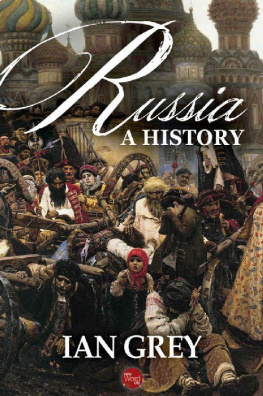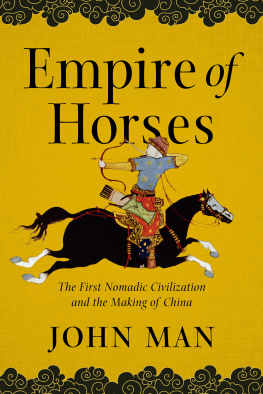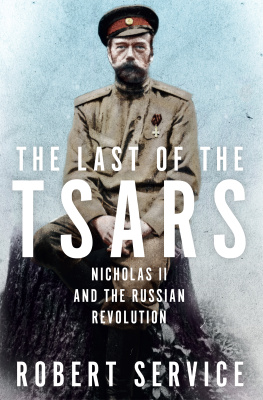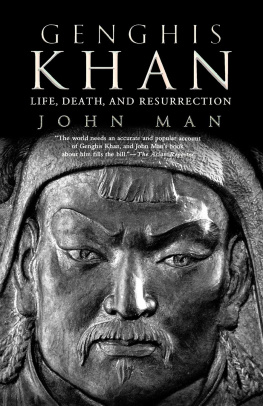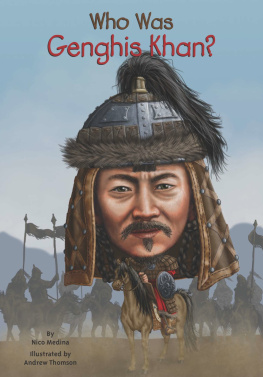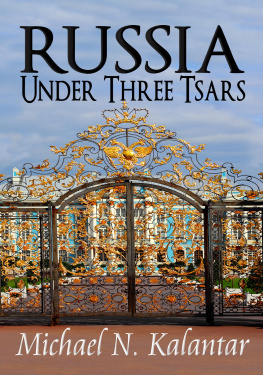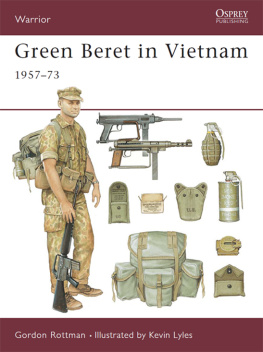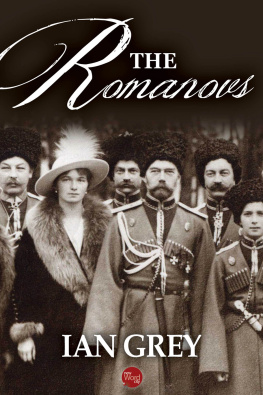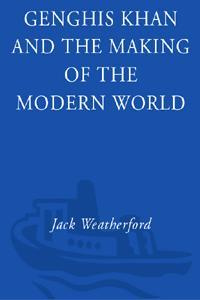Ian Grey - Russia: A History
Here you can read online Ian Grey - Russia: A History full text of the book (entire story) in english for free. Download pdf and epub, get meaning, cover and reviews about this ebook. year: 2015, publisher: New Word City, genre: Art. Description of the work, (preface) as well as reviews are available. Best literature library LitArk.com created for fans of good reading and offers a wide selection of genres:
Romance novel
Science fiction
Adventure
Detective
Science
History
Home and family
Prose
Art
Politics
Computer
Non-fiction
Religion
Business
Children
Humor
Choose a favorite category and find really read worthwhile books. Enjoy immersion in the world of imagination, feel the emotions of the characters or learn something new for yourself, make an fascinating discovery.
Russia: A History: summary, description and annotation
We offer to read an annotation, description, summary or preface (depends on what the author of the book "Russia: A History" wrote himself). If you haven't found the necessary information about the book — write in the comments, we will try to find it.
Russia: A History — read online for free the complete book (whole text) full work
Below is the text of the book, divided by pages. System saving the place of the last page read, allows you to conveniently read the book "Russia: A History" online for free, without having to search again every time where you left off. Put a bookmark, and you can go to the page where you finished reading at any time.
Font size:
Interval:
Bookmark:


The history of Russia is an epic of unending struggle to settle the Eurasian plain, an area of nearly 9 million square miles, the largest extent of land on the Earths surface. The growth of the Russian nation is also the story of extraordinary tenacity and endurance of peoples who have suffered invasion, calamity, and hardship in every century. A generally harsh climate, a terrain that has no effective natural barriers to obstruct migrations and invasions, and a network of mighty rivers have inspired and directed events.
Toward the end of the ice age, some 15,000 years ago, when the glaciers that covered northern Europe began to recede, belts of vegetation evolved that would determine mans future habitation. Within the Arctic Circle, the tundra, a bleak zone of mosses and lichens, is covered with snow and ice for most of the year. South of the tundra is the taiga, a vast belt of dense coniferous forests, broken only by peat bogs, which extends from Finland eastward for 4,000 miles to the Bering Sea. This zone was rich in fur-bearing animals whose pelts would become the economic foundation of the first Russian state.
The zone of mixed pine, fir, and birch forests came next as a roughly triangular wedge stretching eastward from the Baltic and Poland and narrowing gradually into a finger, touching the Ural Mountains. This was a region of dense forests and poor soils, but it had advantages that made it the cradle of the Russian nation. It is the region of the great network of rivers, principal among them the Don, Volga, Dvina, Dnieper, Dniester, which were of tremendous commercial, military, and political significance in Russias history.
The mixed forests merged imperceptibly into the steppe, from the Russian word for lowland, a sparsely wooded grassland. This belt extended from the Carpathian Mountains, rising between modern-day Czechoslovakia and Poland, to the Altai Mountains, bordering Mongolia. Between this belt and the Black Sea stretched the true steppe, the zone of chernaya zemlya, or black earth, that would, over the centuries, become Russias agricultural heartland. Still farther south lay the semi-deserts of Central Asia.
The conflict between forest and steppe zones, between insular and expansive social organization, has been a major factor in the development of the Russian state. The extremes of weather have also played a part. Over most of the plain a continental climate prevails. The upsurge of life in spring and the sudden heat of summer contrast with the savage cold of winter. The people inhabiting this principal area of settlement became inured to these sharp changes in weather and developed great stamina and hardiness. The climate has also contributed to, or even dictated, the tempo of Russian life and the pattern of Russias history - in which periods of quiescence have given way to furious outbursts of activity.
Another physical factor of great importance is the terrain of the Eurasian plain - flat, broken only by a low north-south range of eroded hills, rising little more than 1,500 feet above the plain, known as the Ural Mountains. Though traditionally ascribed the role of barrier between Europe and Asia, the Urals are readily penetrable, with numerous low passes that have proved strategically indefensible for Russia. Lastly, there are the navigable rivers, principally flowing north and south, but with sufficient east-west courses to lace the plain. These rivers, plus easy portages, enabled the Russians and their invaders to travel great distances, even through the forest lands, for purposes of trade and war; though none led directly to open oceans, they did have links with such major seas as the Baltic, the Black, and the Caspian. The flatness of the plain and the system of waterways have given a sense of unity and have promoted acceptance of central authority in Russia, in contrast with Western Europe, where numerous natural barriers encouraged the growth of small sovereign states.
By the time of the Neolithic period in Russia (around 3000 B.C.), the Indo-European peoples of the forests and steppelands were already developing distinctively different ways of life. Hunting and fishing were the chief occupations in the north, whereas the warmer climate and black soil in the south encouraged agriculture and cattle herding. During the Bronze Age (2000-1000 B.C.), the people of the steppes continued to develop more rapidly; the northerners, too, were beginning to keep cattle and to cultivate the land.
Around 1000 B.C., the Cimmerians, generally designated an Aryan people, became the first to rule rather than simply occupy south Russia. About 700 B.C., however, the Scythians displaced them as lords of the steppelands. They were the first of the great waves of nomadic peoples who swept from Asia through Turkistan along the road south of the Urals and into the steppes. The origins of the nomads and the reasons for their surging westward migrations are not certain. Droughts, overpopulation, and the rise of tribes in new strength were certainly some of the factors, but some historians attribute the beginning of historys great Vlkerwanderung, which continued until the thirteenth century, to Chinas intensified campaign against the barbarian peoples harassing their borders.
The Asiatic nomads were horsemen and sturdy, savage warriors. They herded cattle, sheep, and goats, and were constantly on the move to new pastures, their simple possessions being carried in covered wagons in which they also slept. Meat was their main diet, supplemented by kumiss, a fermented drink made from mares milk. They spent lengthy periods in the saddle watching over their herds; on raids or campaigns, they could ride great distances. The short, double-curved bow was their weapon, and in war or on hunting expeditions they could shoot their bronze-tipped arrows with deadly accuracy for several hundred feet. They imposed their bondage over defeated enemies, but allowed them to continue cultivating the land while they levied tribute.
The Scythians were masters of the steppelands at the time when the Greeks established colonies on the northern shores of the Black Sea. Lively trade relations developed between them, with the nomads assimilating elements of Greek culture. But about 200 B.C., the Scythians were swept away by the Sarmatians, an Iranian people who dominated the steppes for some four centuries, levying tribute and actively participating in the rich commerce of the region. In turn, the Sarmatians were conquered by the Goths, a Germanic tribe that, deflected from migrating into parts of southern Europe by the Romans, descended upon south Russia. Though the Goths were not horsemen, they quickly learned the art of fighting in the saddle and thus were able to conquer the steppes. Their rule was cut short by the Huns around A.D. 370. This Asiatic horde, primarily a military force, invaded European Russia, driving the Goths westward and into conflict with the Roman Empire. The Huns established a vast empire, extending from the Volga to the Danube, and they spread terror throughout Europe as they moved inexorably westward. Attila, their greatest leader beginning in about 434 A.D., made his headquarters in the Hungarian plains, exacting tribute from Rome, Constantinople, and numerous lesser states. The Scourge of God, as Attila was called, was poised to conquer Europe when he suddenly died in 453, and the empire of the Huns promptly disintegrated. Succeeding waves of Asian nomads - the Avars; Khazars; Bulgars; Magyars; Pechenegs, or Patzinaks; Cumans, or Polovtsi; Mongols; Turks; and Tatars - came over a period of 1,000 years. The steppelands of southern Russia were like a great highway along which nomadic hordes fought for dominion and for the rich trade between China and Europe, only to be crushed or pushed farther to the west by a new tribe.
Font size:
Interval:
Bookmark:
Similar books «Russia: A History»
Look at similar books to Russia: A History. We have selected literature similar in name and meaning in the hope of providing readers with more options to find new, interesting, not yet read works.
Discussion, reviews of the book Russia: A History and just readers' own opinions. Leave your comments, write what you think about the work, its meaning or the main characters. Specify what exactly you liked and what you didn't like, and why you think so.

